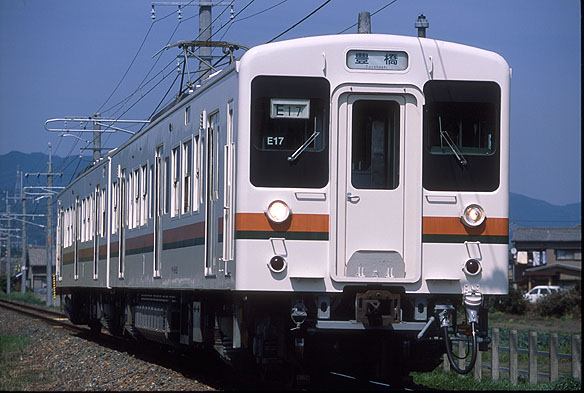Background and overview
Japanese National Railways developed 119 series DC electric multiple unit
(EMU) in order to replace early EMU types used on the rural services of
Iida lines, adopting the single unit system, in 1983. 119 series consist
of a motored end car, class kumoha119, and a trailer end car, class kuha118.
Their formation consists of 1 motored vehicle and 1 trailer vehicle, or
2 motored vehicles and 1 trailer vehicle.
Car body
The 119 series design was based on the earlier 105 series EMU type, having
2800mm wide narrow body. Their body design incorporates lightweight shaped
steel and pressed forming beam to realize a light weight body. A gangway
is fitted in front of every vehicle. Zincate treated aluminum black plate
is fitted around windscreens. They are equipped with 3 double-leaf automatic
sliding doors on each side of the vehicles. Door operating equipments,
TK8, fitted above the door header of the sliding doors can open/close manually
to prevent the passenger's room from being cold in winter. Doors except
centre one are fitted closer to the end of the body than those of 105 series.
Double-hung unit assembled windows and door case windows are fitted between
the doors. Forced draught ventilators are fitted on their roof covered
with polyurethane waterproof coating. The air conditioner is not fitted.
Roller-binding destination screens are fitted on the body.
Bogies
Motored bogies are DT33 for MT55 traction motors and trailer bogies are
DT21T, featuring secondary coil suspension, coil spring primary suspension
with pedestal guide. DT21T bogies are transplanted from disused 101 series
vehicles. Motored bogies employ single tread brake device and trailer bogies
employ double tread brake device.
Traction unit and ancillary equipments
Class kumoha119 vehicles are equipped with an armature-resistance traction
system, CS54, which controls four series-wound brushed DC traction motors,
MT55A with a power output of 110 kW, which are connected in series, featuring
holding braking. Their natural-draft traction resistance is MR154, of which
capacity is higher than MR147 of 105 series EMU due to continuous duty
caused by use of holding braking. Class kumoha119 vehicles are also equipped
with a diamond-shaped current pickup, PS23A, on the roof, with a motor
driven reciprocating air compressor, MH80A-C1000M, and a transplanted motor
generator, MH97-DM61A, with a power output of 20kVA under the floor. Their
gear ratio is 6.07. they adopt electromagnetic straight air brake with
rheostatic brake.
Accommodation
Seating is arranged as mixture of longitudinal bench seating and transverse seating bays with 1470mm seating pitch. Electric fans are fitted under the ceiling. Trailer end cars, class kuha118, have a Japanese style toilet.
Operations
119 series entered the revenue services of Iida line in 1983.
Modification and History of Operations
In 1986, JNR began to fit air conditioners, AU75, onto 119 series to relocate
to Tokaido line shuttle services in Shizuoka region. After the splitting
of the former JNR into the new privatized JR companies, JR Central remodeled
some of class kumoha119 vehicles into single car by adding the cab section
onto the vehicles end of the vehicles and classified into -100 subclass.
JR Central also began to fit air conditioners, C-AU711A, to the no airconditioned
119 series vehicles and classified into -5000 subclass. 119 series vehicles
used on Tokaido line shuttle services were replaced with 211 series and
returned to rural services of Iida line.
Although 119 series EMU had been used on the rural services of Iida line, they were displaced with 213-5000 series and withdrawn in 2012. |
|
 Kumoha119-5100
Kumoha119-5100
 Kumoha119-5100
Kumoha119-5100